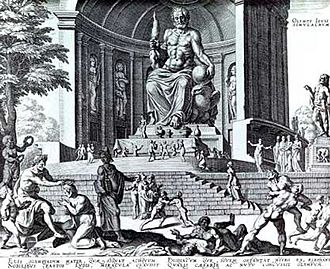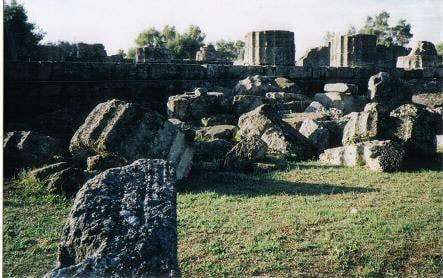Difference between revisions of "Ancient Olympia" - New World Encyclopedia
m (→External links) |
|||
| Line 6: | Line 6: | ||
The sanctuary itself consists of an unordered arrangement of various buildings. To the north of the sanctuary can be found the prytaneion and the Philippeion, as well as the array of treasuries representing the various city states. The metroon lies to the south of these treasuries, with the Echo Stoa to the East. To the south of the sanctuary is the South Stoa and the Bouleuterion, whereas the West side houses the palaestra, the workshop of Pheidias, the Gymnasion and the Leonidaion. Enclosed within the temenos are the temples of Hera and Zeus, the Pelopion and the area of the altar, where the sacrifices were made. The hippodrome and later stadium were also to the East. | The sanctuary itself consists of an unordered arrangement of various buildings. To the north of the sanctuary can be found the prytaneion and the Philippeion, as well as the array of treasuries representing the various city states. The metroon lies to the south of these treasuries, with the Echo Stoa to the East. To the south of the sanctuary is the South Stoa and the Bouleuterion, whereas the West side houses the palaestra, the workshop of Pheidias, the Gymnasion and the Leonidaion. Enclosed within the temenos are the temples of Hera and Zeus, the Pelopion and the area of the altar, where the sacrifices were made. The hippodrome and later stadium were also to the East. | ||
| + | |||
| + | == Discovery == | ||
| + | The excavation of Olympia was attributed to German-born archaeologist [[Ernst Curtius]]. Curtius was extremely systematic in his work. In the period from 1875 to 1881, almost the whole of Olympia was unearthed, revealing some of the most beautiful artistic pieces of Ancient Greece. Besides numerous coins and inscriptions, Curtius also found the well-preserved statue of Hermes carrying the infant Dionysus by Praxiteles. Curtius also found the temple of Hera, the altar of Zeus, the former site of the enormous statue of Zeus (one of the Seven Wonders of the World), and the original location of the Olympic stadium, where the Olympic Games took place in Ancient Greece. | ||
===Architecture of the palaestra === | ===Architecture of the palaestra === | ||
| Line 44: | Line 47: | ||
| − | + | ||
| − | |||
Revision as of 01:54, 19 November 2006
Olympia (Greek: Ολυμπία Olympí'a or Ολύμπια Olýmpia, older transliterations, Olimpia, Olimbia), a sanctuary of ancient Greece in Elis, is known for having been the site of the Olympic Games in classical times, comparable in importance to the Pythian Games held in Delphi. Both games were held every olympiad (i.e. every four years), the Olympic Games dating back possibly further than 776 B.C.E. In 394 Emperor Theodosius I, or possibly his grandson Theodosius II in 435, abolished them because they were reminiscent of paganism.
The sanctuary itself consists of an unordered arrangement of various buildings. To the north of the sanctuary can be found the prytaneion and the Philippeion, as well as the array of treasuries representing the various city states. The metroon lies to the south of these treasuries, with the Echo Stoa to the East. To the south of the sanctuary is the South Stoa and the Bouleuterion, whereas the West side houses the palaestra, the workshop of Pheidias, the Gymnasion and the Leonidaion. Enclosed within the temenos are the temples of Hera and Zeus, the Pelopion and the area of the altar, where the sacrifices were made. The hippodrome and later stadium were also to the East.
Discovery
The excavation of Olympia was attributed to German-born archaeologist Ernst Curtius. Curtius was extremely systematic in his work. In the period from 1875 to 1881, almost the whole of Olympia was unearthed, revealing some of the most beautiful artistic pieces of Ancient Greece. Besides numerous coins and inscriptions, Curtius also found the well-preserved statue of Hermes carrying the infant Dionysus by Praxiteles. Curtius also found the temple of Hera, the altar of Zeus, the former site of the enormous statue of Zeus (one of the Seven Wonders of the World), and the original location of the Olympic stadium, where the Olympic Games took place in Ancient Greece.
Architecture of the palaestra
The palaestra at Olympia is part of the gymnasium at the sanctuary. This sixty-six meter square building dates to the end of the third or beginning of the second century B.C.E.
The palaestra is oriented precisely to the cardinal points and is very symmetrical in plan. Like all palaestra, the palaestra at Olympia is centered around a large courtyard covered with sand for use as a boxing or wrestling surface. Along all four sides of the palaestra are rooms that opened onto the porticoes.
The building is entered through the south side through two separate doorways, each with Corinthian columns distyle in antis, thus immediately establishing symmetry within the plan of the structure. The doorways open into bench-lined vestibules leading to anterooms that open directly onto the southern portico. Between the two anterooms is a long, shallow hall lined with benches and faced with Ionic columns. This room is identified as the apodyterion, or undressing room, a space that would need to be close to the main entrance and have room for athletes and friends to meet. Directly across from the apodyterion, along the north side of the palaestra is the ephebion, or clubroom. This large, colonnaded hall is deeper than the apodyterion but does not run the entire length of the courtyard. The entire north side of the palaestra has deep rooms, a feature mentioned by Vitruvius, which offered shelter from the sun. Also in the north side of the building is a doorway that leads directly into the rest of the adjoining gymnasium space. The room in the northeast corner of the palaestra is identified as a bathroom. The brick-lined, 4 meter square and 1.38 meter deep tank found here is dated to the Roman period, however.
An unusual feature of the palaestra is the 24.20 by 5.44 meter strip of concrete pavement on the north side of courtyard, which is formed with alternate bands of ribbed and smooth tiles arranged to create continuous ridges stretching the length of the pavement. This was probably a sort of bowling alley, as suggested by a similar pavement found at Pompeii with heavy stone balls on it.
It is not possible to say for what most of the other rooms lining the porticoes were used. Since Olympia had no resident population, the palaestra and gymnasium would not have included spaces for lectures or intellectual discourse and would have been used primarily by competitors in the sanctuary games. The stone benches found in six of rooms would certainly have been used by athletes and spectators rather than by intellectuals. The unidentified rooms of the palaestra would have included rooms such as the elaiothesion or oil store, the konisterion or dusting-room, rooms for storing athletic apparatus, and a few sphairisteria, which were rooms or open courts for ball play.

Phidias created the 12-m (40-ft) tall statue of Zeus at Olympia about 435 B.C.E. The statue was perhaps the most famous sculpture in ancient Greece, imagined here in a 16th-century engraving.
Olympia is also known for the gigantic ivory and gold statue of Zeus that used to stand there, sculpted by Pheidias, which was named one of the Seven Wonders of the Ancient World by Antipater of Sidon. Very close to the temple of Zeus (see photo of ruins below) which housed this statue, the studio of Pheidias was excavated in the 1950s. Evidence found there such as sculptor's tools, corroborates this opinion.
Excavation of the Olympia temple district and its surroundings began with a French expedition in 1829. German archaeologists continued the work in the latter part of the 19th century. The latter group uncovered, intact, the Hermes of Praxiteles statue, among other artifacts. In the middle of the 20th Century, the stadium where the running contests took place was excavated.
The Olympic flame of the modern-day Olympic Games is lit by reflection of sunlight in a parabolic mirror at the restored Olympia stadium and then transported by a torch to the place where the games are held.
When the modern Olympics came to Athens in 2004, the men's and women's shot put competition was held at the restored stadium.
The ancient ruins sits north of the Alfeios River and lies next to Cronius or Kronios hill (the hill of Kronos, or Saturn). Kladeos, a tributary of Alfeios, flows around the area.
The town has a school and a square (plateia). Tourism is popular throughout the late-20th century. The city has a train station and is the easternmost terminus of the line of Olympia-Pyrgos (Ilia). The train station which the freight yard is west of it is about 300 m east of the town centre.
It is linked by GR-74 and the new road was opened in the 1980s, the next stretch N and NE of Olympia will open in around 2005. Distance from Pyrgos is 20 km E(old: 21 km), about 50 km SW of Lampeia, W of Tripoli and Arcadia and 4 km north of Krestena and N of Kyparissia and Messenia. The highway passed north of the ancient ruins.
A reservoir is located 2 km southwest damming up the Alfeios river and has a road from Olympia and Krestena which in the late-1990s has been closed.
The area is hilly and mountainous, most of the area within Olympia is forested.
External links
- Perseus Digital Library, Olympia
- Athletic history in the palaestra
- The Official Website of Olympia, Greece
- Harry Thurston Peck, Harper's Dictionary of Classical Antiquities, (1898): "Olympic Games"
- traveljournals.net - Olympia
- Olympia photos and info
- traveljournals.net/explore/greece/map/m1214007/olimbia_arkhaia traveljournals.net - Ancient Olympia
- GTP - Ancient Olympia
- GTP - Municipality of Ancient Olympia
- GTP - Ancient Olympia
- Olympia photo gallery
- Indexmundi - Olympia
- Olympia - extensive black and white photo-essays of the site and related artifacts
Credits
New World Encyclopedia writers and editors rewrote and completed the Wikipedia article in accordance with New World Encyclopedia standards. This article abides by terms of the Creative Commons CC-by-sa 3.0 License (CC-by-sa), which may be used and disseminated with proper attribution. Credit is due under the terms of this license that can reference both the New World Encyclopedia contributors and the selfless volunteer contributors of the Wikimedia Foundation. To cite this article click here for a list of acceptable citing formats.The history of earlier contributions by wikipedians is accessible to researchers here:
The history of this article since it was imported to New World Encyclopedia:
Note: Some restrictions may apply to use of individual images which are separately licensed.
